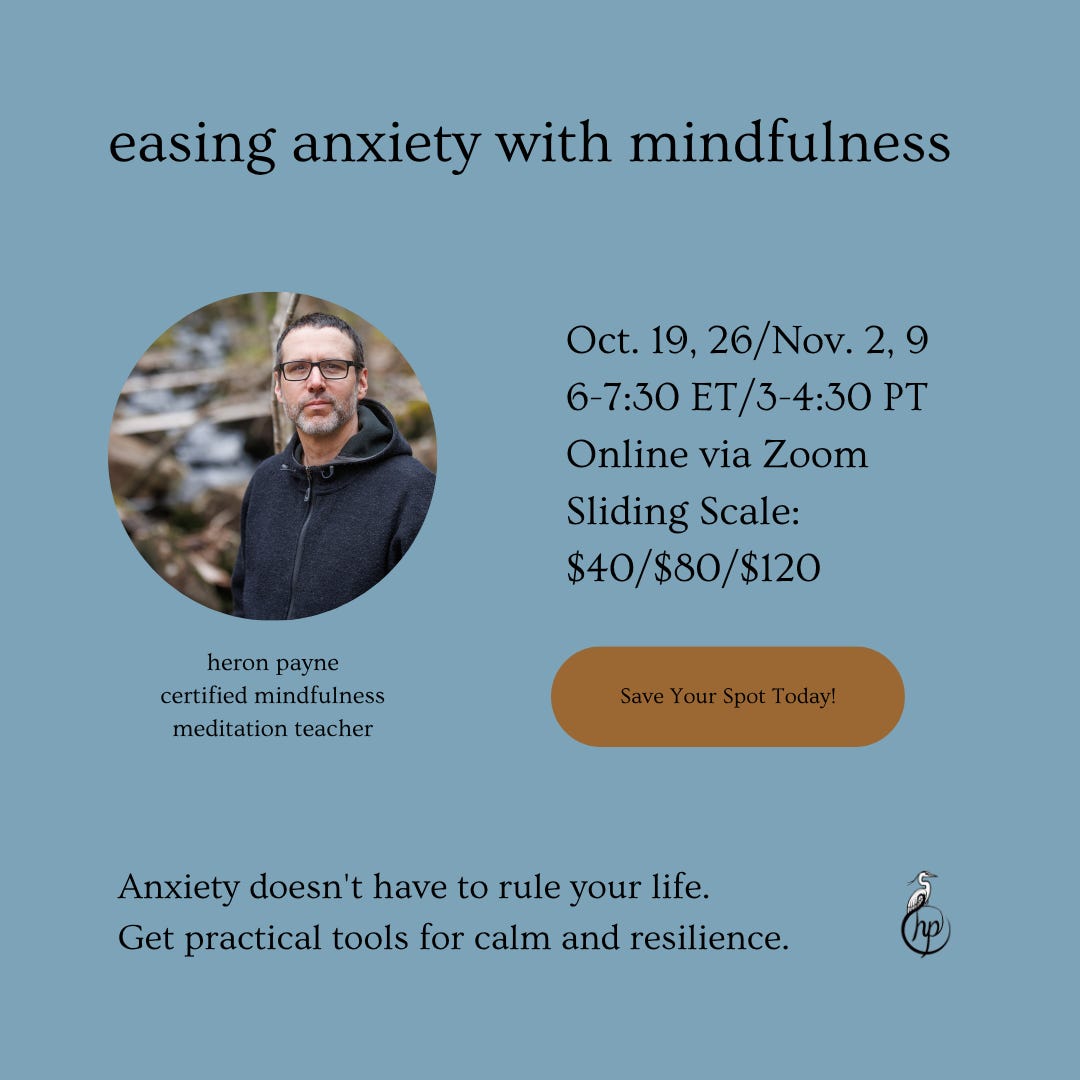About that time I wrestled a bear
Or, how I discovered the storytelling mind's true nature and learned to see beyond the waterfall of thoughts.
It was sitting beside a crackling fire on the first night of a solo backpacking trip in Washington’s High Cascade Mountains, when I heard a rustling in the old-growth cedar forest.
Before I set out, the park ranger warned me in his western drawl to watch out for ‘bars’ (bears). Fresh from Atlantic Canada, where bears are timid and rarely seen, I immediately felt uneasy.
I’d weathered many nights alone in Newfoundland’s woods and even survived a close encounter with a startled moose. But here, solo, far from home and deep in an unfamiliar wilderness, things were different.
My mind was already on high alert for danger. So, when I heard that sound in the woods, I decided it was a grizzly that wanted to make an evening meal out of me.
I sat by the fire for hours with my buck knife stuck in the ground, bear spray in hand, shining a powerful flashlight into the dense forest. My mouth soured by adrenaline, ready to fight or flee. I screamed at the sound repeating from the unknown until my throat was sore.
Even in the midst of it, as I sat there raging and terrified, part of me knew there wasn’t actually a bear out there.
Despite this inner knowing, I was so stuck in the anxious “bear’s about to eat me” story that I couldn’t see any other possibilities.
The storytelling mind
I’m here writing these words. So, clearly I lived to tell the story. But, believe it or not, there was a ferocious bear in the forest with me that night.
It was my wild storytelling mind, and it had complete control over me.
Stories are powerful things. They can capture our attention and take us away from the present moment into the most fantastical places.
And, our minds are amazing at telling them.
The challenge, as you can see from my story above, is that the stories our minds concoct are often—at best—not helpful. They can even be harmful.
They can pull us into narratives that have no basis in reality. They can take us away from the joy, beauty, and connection of being here in the present moment.
For example, you might pause for a moment and imagine that you’re riding through the sky on the back of a dragon. Feel the wind in your face and taste the scorched, sulfurous air of your pet dragon’s fiery breath.
The human mind can conjure up such images easily. But that doesn’t make them true. Our other, more mundane thoughts often have as little to do with reality as riding a dragon.
Thanks to this habit of mind, instead of savouring fresh mountain air, a crackling fire, and the kiss of sunlight fading on the bark of ancient cedars—I was stuck in a painful and totally unreal mental narrative.
Seeing the waterfall
As I’ve mentioned before, for a long time I hated my anxiety and the ways it limited my life. So, I was brutally hard on myself after my “bear encounter.”
Looking back on my journal from that night, several other stories lived inside the bear narrative: “I’m a coward.” “My stupid mind is going to ruin yet another trip.”
Little did I know how normal a human experience I was having in that moment.
Our minds are thought-generating machines. They produce thoughts like the heart beats or the lungs breathe.
(Add some trauma to the picture, as in my case, and that thinking machine can get kicked into overdrive. It spews out endless worst-case scenarios and doomsday predictions.)
My initial glimpse into the thinking mind’s true nature came about a year after that night in the Cascades, when I did my first meditation retreat.
At this point, I’d never even tried meditation before. So, doing five days’ worth of intensive Vipassana meditation at a Thai Forest monastery was a dive into the deep end befitting a 25-year-old hellbent on testing his mettle.
It’s as if we live inside a powerful torrent of thoughts. We’re so inundated by the deluge that we can’t see beyond it.
The retreat turned out to be torturous. Even when I sat in the safe and serene monastic environment, that wild animal mind was still with me. When I tried to get quiet in meditation, my brain kept playing thoughts of all kinds like a skipping record. This went on for hours each day.
I came away from the retreat feeling stressed and like the whole thing was a flop.
Little did I know at the time how important an insight I had gained: The mind’s nature is to think and make up stories.
My teacher, Jack Kornfield, calls this experience “seeing the waterfall.” It’s as if we live inside a powerful torrent of thoughts. We’re so inundated by the deluge that we can’t see beyond it.
My first experience with mindfulness meditation gave me a glimpse of the waterfall— just enough to be able to acknowledge its presence.
Thoughts are REAL but not TRUE
In the years following that retreat, I continued practicing meditation. I read books, took some training, and maintained a sporadic practice. But it was hard.
Every time I meditated, my mind reeled with thoughts and kept repeating the same old stories. That made it hard, which discouraged me from practicing. So the cycle perpetuated itself.
In retrospect, I was missing a key piece of instruction.
At the time, I thought the goal of meditation was to stop my thoughts. So, when I not only couldn’t stop thinking, but often drifted into scary stories, I felt like a failure. That added a layer of shame on top of an already difficult experience.
The learning that changed everything for me and helped me finally establish a regular meditation practice is quite simple—but profound:
“Thoughts are real, but not true.”
So, along with thinking being a normal human experience, we also don’t have to believe what our thoughts are telling us. In fact, science has indicated that we should be skeptical about our thinking.
Don’t believe your thoughts. Even the ones that say you should trust them.
A study by Dr. Michael Gazzinga in the 1960s showed that the left side of the brain’s job is to make up explanations and reasons to help make sense of our experience. But the left brain is essentially an interpreter of reality, and Gazzinga found that it often gets things totally wrong.
So, I reiterate: Don’t believe your thoughts. Even the ones that say you should trust them.
The two learnings above were transformational for me. I could sit in meditation and not stress about the fact that I was thinking, nor the content of the thoughts.
Instead, I could practice seeing what’s present and noticing it without judgement. It was incredibly freeing. It opened the doors to a consistent and fruitful mindfulness meditation practice that’s helped transform my life.
Seeing behind the waterfall.
Back to that night in the High Cascades. Eventually, I ran out of wood, and the fire died down. My mind calmed along with it.
I had finally let go of the story that there was a wild animal in the forest waiting to get me.
I got up to douse the embers and head off to bed, exhausted. But, without the light from the fire, I noticed that the sky above me was brilliantly clear and filled with countless stars.
So I sat, propped up against a rock, for who knows how long, staring and marvelling at the mystery of the night sky. Then I took the fly off my tent, crawled into my sleeping bag, and continued to gaze upward as I drifted into a deep sleep.
That night sky is the perfect metaphor for what I now know exists behind our waterfall of endless thinking and storytelling. It’s a vast, wide-open space full of endless potential and unfathomable beauty.
It’s always there. But we seldom see it because it’s blocked by the thoughts and stories that cloud our minds.
Mindfulness practice lets us step outside that waterfall and get some distance, so we can see the world around us with more clarity and calm.
It’s definitely made my mind a much easier place to be. The old stories are still there. But they don’t show up as much or have the same power they once did.
I still spend entire meditations with my mind in planning, remembering, or [insert type of thought] mode. But I’m ok with that. Compassion tells me it’s a normal human experience, and I can be kind to myself in the midst of it.




